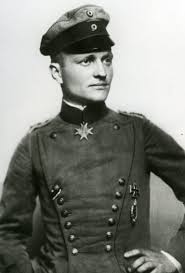
Manfred Freiherr von Richthofen
On 24 June, Richthofen was appointed to command the new Jagdgeschwader 1, a fighter wing comprising four Jagdstaffeln. In July 1917, he was again shot down, but was less lucky this time and sustained a head wound and skull fracture. He was to suffer headaches thereafter, but was back flying on 16 August, 40 days after being shot down. On 31 August, he scored his first victory flying a Fokker triplane, an aircraft with which he is particularly associated, but he already had a score of 59 kills (out of his final total of 80) so most of his successes were not in the triplane. The triplane had been hastily copied from the Sopwith triplane, an example of which had force-landed into German-held territory. The Fokker machine, however, had problems because the top wing was collapsing in flight and the rotary engine oil was proving unsatisfactory. Richthofen met his death on 21 April 1918 and it has been established, almost without doubt, that he fell victim to ground fire from an Australian machine gunner. He had been showing signs of combat fatigue and was still probably affected by his earlier head wound, but he had broken his own rules by following a victim down to low level.
Werner Voss
He scored his first victory on 27 November 1916, flying an Albatros D.III (with a white swastika on the fuselage), which earned him the Iron Cross. Converting to the Fokker triplane, his final total of victories amounted to 48. He met his death in combat with seven SE5s piloted by some of the best pilots of the RFC, including James McCudden, who described the combat in his book Flying Fury (pages 186 and 187):
The Hun triplane was practically underneath our formation now, and so down we dived at colossal speed. I went to the right, and Rhys-Davids to the left, and we got behind the triplane together. The German pilot saw us and turned in a most disconcertingly quick manner, not a climbing nor Immelmann turn, but a sort of flat half spin. By now the German triplane was in the middle of our formation, and its handling was wonderful to behold. The pilot seemed to be firing at all of us simultaneously, and although I got behind him a second time, I could hardly stay there for a second. His movements were so quick and uncertain that none of us could hold him in sight at all for any decisive time. … I had temporarily lost sight of the triplane whilst changing a drum of my Lewis gun, and when I next saw him he was very low, still being engaged by an S.E. marked I, the pilot being Rhys- Davids. I noticed that the triplane’s movements were very erratic, and then I saw him go into a fairly steep dive and so I continued to watch, and then saw the triplane hit the ground and disappear into a thousand fragments, for it seemed to me that it literally went into powder. … His flying was wonderful, his courage magnificent, and in my opinion he is the bravest German airman … it has been my privilege to fight.
Voss was an individualist and led by example, but the days of single aircraft surviving had passed with the increased use of large formations.